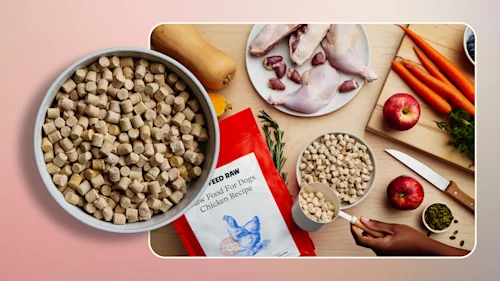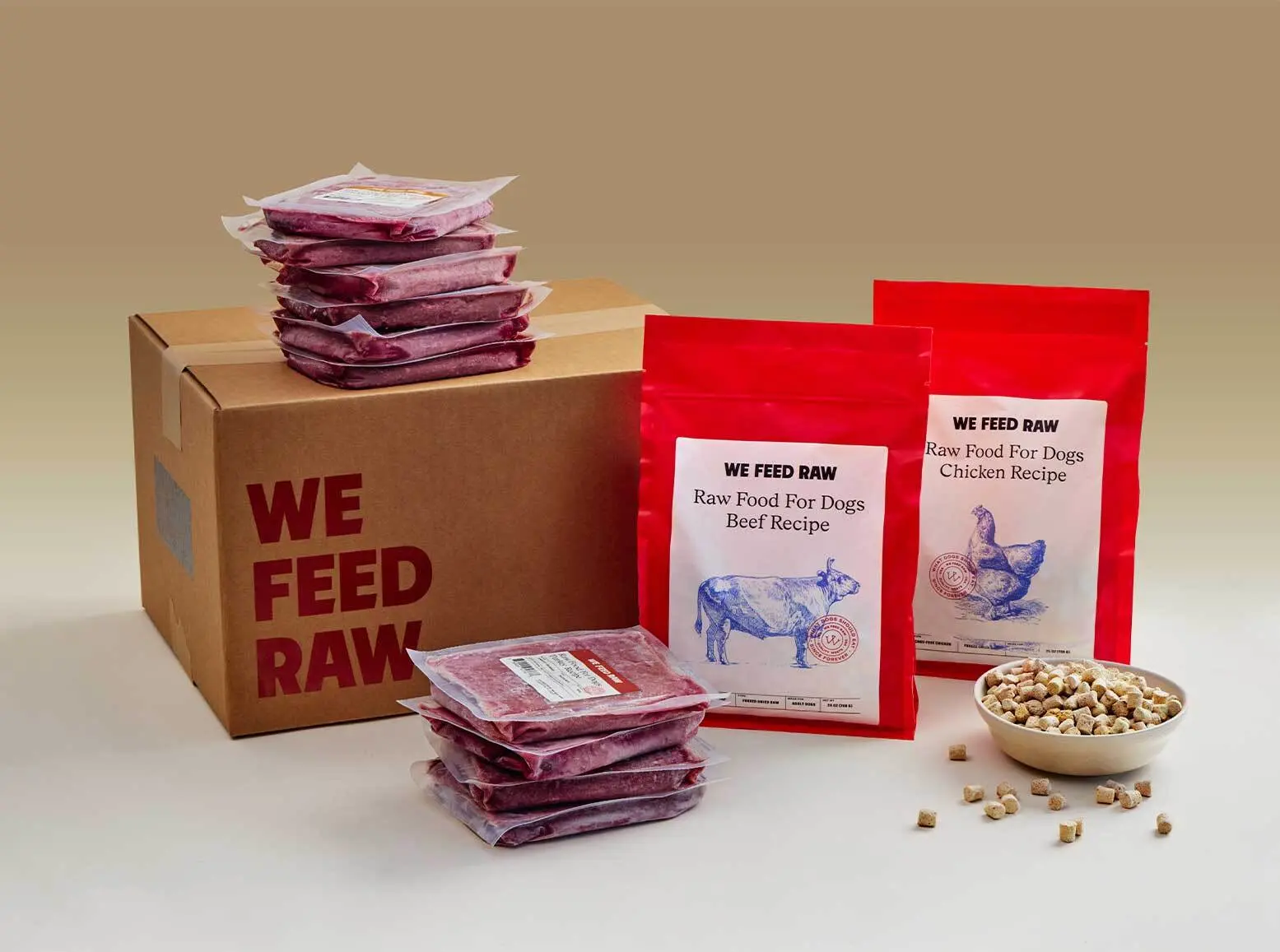
What Raw Foods Can Dogs Eat?
Table of Contents
Dogs can eat many raw foods, including raw muscle meat, organ meat, and bones as well as small fish and some fruits and vegetables. Raw food is good for dogs because they’re descended from wolves, and their bodies are still ideally suited for processing raw animal products rather than trying to extract nutrients from plant matter.
In this blog post, we'll discuss the different types of raw foods that dogs can eat, including muscle meat, organ meat, and bones. We'll also provide tips on how to safely feed your dog a raw food diet.
What Is a Raw Diet for Dogs?
A raw diet for dogs mimics what their wild ancestors would have eaten. It primarily consists of uncooked ingredients, focusing on whole, unprocessed foods. A balanced raw diet typically includes:
•Muscle Meat: This is the primary component, providing protein and essential amino acids.
•Raw Bones: Edible bones provide calcium and phosphorus, and they also help clean teeth. Bones must be raw, as cooked bones can splinter and be dangerous.
•Organ Meats: These are nutrient powerhouses, rich in vitamins and minerals. Liver, kidney, heart, and other organs are important components of a balanced raw diet.
•Other Additions: Depending on the specific recipe or philosophy, some raw diets may also include small amounts of raw eggs, fruits, vegetables, or supplements.
The goal is to provide a diet that is biologically appropriate, meaning it aligns with a dog's natural digestive system and nutritional needs. Creating a balanced raw diet requires careful planning and research to ensure your dog receives all the necessary nutrients, but We Feed Raw makes it easy by delivering nutritionally complete and balanced frozen raw dog food to your door.
What Are the Benefits of Raw Dog Food?
Some of the benefits of raw dog food meals include:
•Improved Digestion: Raw food is easier for dogs to digest due to the presence of natural enzymes and the lack of species-inappropriate carbohydrates.
•Healthier Skin and Coat: The essential fatty acids and nutrients in raw food can contribute to a shinier coat and healthier skin.
•Increased Energy Levels: A biologically appropriate diet can provide dogs with sustained energy.
•Stronger Immune System: A nutrient-rich raw diet can support a healthy immune system.
•Reduced Stool Volume: Raw diets can result in smaller, firmer poops.
Even beyond the regular raw food benefits, We Feed Raw as a premade raw dog food offers even more benefits, including the convenience of regular deliveries and no need to weigh or portion anything.
What Foods Can Dogs Eat Raw?
Dogs can eat a surprising number of foods raw, including:
•Muscle Meats: Beef, lamb, duck, chicken, turkey, and venison are all excellent sources of protein. Choose cuts appropriate for your dog's size and chewing ability.
•Organ Meats: Liver, kidney, heart, spleen, and pancreas are nutrient-dense organs that should be included in a balanced raw diet. They are best offered in moderation.
•Raw Bones: Edible bones, such as chicken necks, backs, or wings (for smaller dogs), and larger bones like beef femurs (for larger dogs), provide calcium and phosphorus. Never feed cooked bones, as they can splinter and be dangerous.
•Raw Eggs: Eggs are a good source of protein and other nutrients. They can be fed whole or just the yolk.
•Fish: Some raw fish, like sardines or anchovies, can be a healthy addition to a raw diet, providing omega-3 fatty acids. Keep in mind, however, that larger fish like salmon and tuna may contain high levels of mercury.
•Some Fruits and Vegetables: While dogs don’t require any fruits or vegetables in their diet, many pups enjoy the occasional fruit or veggie snack.
Risky Foods to Avoid in a Raw Diet for Dogs
While a raw diet can be beneficial, it's crucial to be aware of foods that are not safe for dogs, even in their raw state. Avoid for your dog's health and well-being:
•Cooked Bones: These are extremely dangerous. Cooking changes the bone's structure, making it brittle and prone to splintering. These splinters can cause serious internal injuries.
•Grapes and Raisins: These fruits are toxic to dogs and can cause kidney failure.
•Onions: These members of the allium family can damage red blood cells and lead to anemia in dogs.
•Chocolate: Chocolate contains theobromine, a toxic substance for dogs. The darker the chocolate, the more dangerous it is.
•Avocado: While the flesh of avocado is generally considered safe in small amounts, the pit and skin contain persin, which can cause vomiting and diarrhea in dogs.
•Macadamia Nuts: These nuts are toxic to dogs and can cause a range of symptoms, including weakness, tremors, and vomiting.
•Xylitol: This artificial sweetener is extremely dangerous for dogs and can cause a rapid drop in blood sugar, liver failure, and even death. It's often found in sugar-free gum, candy, and baked goods.
If you are unsure about the safety of a particular food, it's always best to err on the side of caution and avoid feeding it to your dog. Consult with your veterinarian or a veterinary nutritionist for guidance on safe and appropriate foods for your dog's raw diet.
What Age Can Dogs Eat Raw Food?
Puppies can start eating raw food as soon as they start weaning around 3-4 weeks of age. Since puppies have sensitive stomachs and not much of an immune system yet, it’s best to start them on a nutritionally balanced food like We Feed Raw that goes through high-pressure processing (HPP) to inactivate potential pathogens.
Additionally, studies show that puppies fed a raw diet are less likely to struggle with ear infections, skin allergies, and gut problems.
Raw Dog Food Precautions
While a raw diet can offer numerous benefits, it's crucial to take precautions to ensure your dog's safety and well-being:
•Hygiene Is Key: Always wash your hands thoroughly after handling raw meat and bones. Clean all surfaces, bowls, and utensils that come into contact with raw food to prevent the spread of bacteria.
•Source Responsibly: Choose high-quality raw ingredients from reputable suppliers to minimize the risk of contamination.
•Proper Storage: Store raw meat and bones in the refrigerator or freezer to prevent spoilage. Thaw frozen food safely in the refrigerator, not at room temperature.
•Balanced Diet: Ensure your dog's raw diet is nutritionally complete and balanced. Consult with a veterinary nutritionist or use a reputable, pre-made raw food diet to avoid nutritional deficiencies.
By following these precautions, you can minimize the potential risks associated with raw feeding and provide your dog with a safe and healthy diet.
Ensure Your Dog’s Raw Food Is Safe
The best way to ensure your dog’s raw diet is safe is by choosing to give them We Feed Raw. Our recipes were formulated by a highly experienced PhD animal nutritionist to be nutritionally complete and balanced.
We also source our meats from human-grade food chains and use HPP to ensure our food is free of pathogens, including avian flu.
Addressing Misconceptions
Raw feeding, while growing in popularity, often faces misconceptions. Let's address some common concerns.
"Raw Food Is Dangerous Due to Bacteria"
While it's true that raw meat can contain bacteria, reputable suppliers and proper handling practices significantly minimize this risk. Just like with handling raw meat for human consumption, good hygiene is essential.
Furthermore, a dog's digestive system is designed to handle certain bacteria that would be harmful to humans.
You can also choose a food like We Feed Raw that uses HPP to inactivate potential pathogens.
"Raw Diets Are Too Complicated"
Creating a balanced raw diet from scratch can be complex. However, convenient, pre-made raw food options, like We Feed Raw, take the guesswork out of the equation, providing complete and balanced nutrition in easy-to-serve formats.
"Raw Diets Are Too Expensive"
While high-quality raw dog food does tend to be more expensive than kibble, you may save money down the road on vet bills since your pup is likely to be healthier.
You also don’t need to switch your dog to a completely raw diet. They can see health benefits by even adding 25% raw food to their daily kibble.
Choose We Feed Raw for Convenience and Quality
We Feed Raw takes the guesswork and hassle out of raw feeding, allowing you to provide your dog with the benefits of a biologically appropriate diet without the complexities of preparation. Our meals are:
•Nutritionally Complete and Balanced: Formulated by a PhD animal nutritionist, our recipes are designed to meet all your dog's nutritional needs.
•Made With High-Quality Ingredients: We use only USDA-certified, human-grade meats and carefully selected ingredients.
•Convenient and Easy to Serve: Our pre-portioned, frozen patties simply require thawing, making mealtime a breeze.
•Safe and Reliable: We employ rigorous safety measures, including high-pressure processing (HPP), to inactivate potentially harmful bacteria.
•Delivered to Your Doorstep: Enjoy the convenience of having nutritious, raw meals delivered directly to you, saving you time and effort.
With We Feed Raw, you can confidently provide your dog with a premium raw diet, knowing they are receiving the best in nutrition, quality, and convenience. Review our products or start your dog’s meal plan today.
Frequently Asked Questions (FAQs)
What raw food can dogs eat safely as part of their diet?
Dogs can safely eat a variety of raw foods, including muscle meats (beef, lamb, duck, chicken, turkey, venison), organ meats (liver, kidney, heart), raw meaty bones, raw eggs, and certain types of raw fish (like sardines or anchovies). It's crucial to choose high-quality ingredients from reputable sources and prepare them safely.
Always avoid cooked bones, grapes, raisins, onions, garlic, chocolate, avocado, macadamia nuts, and xylitol, as these are toxic to dogs.
At what age is it appropriate for dogs to start a raw food diet?
Dogs can start eating raw food as soon as they start weaning around 3-4 weeks of age. The safest way to feed a puppy a raw diet is with nutritionally complete and balanced meals from We Feed Raw that go through high-pressure processing to inactivate potential pathogens.

Our Meals Change Lives.
(Theirs + Yours.)
See health improvements from our raw meals in as little as 1 week.
